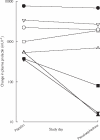Pseudoephedrine: effects on milk production in women and estimation of infant exposure via breastmilk
- PMID: 12848771
- PMCID: PMC1884328
- DOI: 10.1046/j.1365-2125.2003.01822.x
Pseudoephedrine: effects on milk production in women and estimation of infant exposure via breastmilk
Abstract
Aims: To assess the effects of pseudoephedrine on breast blood flow, temperature and milk production, and to estimate the likely infant dose during breastfeeding.
Methods: Eight lactating women (mean age 35 years and weight 69 kg) participated in a single-blind randomized crossover study of 60 mg pseudoephedrine hydrochloride vs placebo. Breast blood flow and surface temperature were measured from 0 to 4 h following the dose, and change in plasma prolactin was measured as the difference between predose and 1 h postdose concentrations. Milk production was measured for 24 h following placebo and pseudoephedrine. Infant dose of pseudoephedrine for a 60-mg dose administered four times daily to the mother was quantified as the product of average steady-state drug concentration in milk and an estimated milk production rate of 0.15 l x kg(-1) x day(-1) and expressed relative to the maternal weight-adjusted dose.
Results: There were no physiologically significant changes in breast blood flow or temperature between the placebo and pseudoephedrine periods. The mean change in plasma prolactin was slightly (13.5%), but not significantly lower (t = 1.245, P = 0.253) after pseudoephedrine (1775 mU x l(-1)) compared with placebo (2014 mU x l(-1)). However, the mean milk volume was reduced by 24% from 784 ml x day(-1) in the placebo period to 623 ml x day(-1) in the pseudoephedrine period (difference between means 161 ml x day(-1) (95% CI: 63, 259 ml x day(-1)); t = 3.9, P = 0.006). Assuming maternal intake of 60 mg pseudoephedrine hydrochloride four times daily, the estimated infant dose of pseudoephedrine was 4.3% (95% CI, 3.2, 5.4%) of the weight-adjusted maternal dose.
Conclusions: A single dose of pseudoephedrine significantly reduced milk production. This effect was not attributable to changes in blood flow, but depression of prolactin secretion may be a contributing factor. At the maximum recommended pseudoephedrine doses, the calculated infant dose delivered via milk was < 10% of the maternal dose, and is unlikely to affect the infant adversely. The ability of pseudoephedrine to suppress lactation suggests a novel use for the drug.
Figures


References
-
- Committee on Drugs of the American Academy of Pediatrics. The transfer of drugs and other chemicals into human milk. Pediatrics. 1994;93:137–150. - PubMed
-
- Mitchell JL. Use of cough and cold preparations during breastfeeding. J Hum Lact. 1999;15:347–349. - PubMed
-
- Anderson PO. Decongestants and milk production. J Hum Lact. 2000;16:294. - PubMed
-
- Mepham B. Physiological aspects of lactation. In: Mepham B, editor. Biochemistry of Lactation. New York: Elsevier; 1983. pp. 2–28.
Publication types
MeSH terms
Substances
LinkOut - more resources
Full Text Sources
Research Materials

